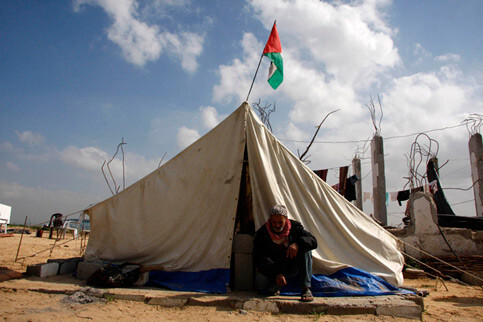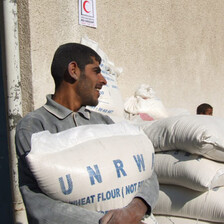The Electronic Intifada 19 May 2010

An elderly man sits outside his UNRWA-supplied tent in northern Gaza. His home was destroyed in the winter 2008-09 Israeli assault. (Suhair Karam/IRIN)
DUBAI (IRIN) - With a failing economy, rising unemployment and deteriorating power, sanitation and health facilities, the health of Gaza’s population continues to worsen, according to a recent World Health Organization (WHO) report. In contrast, modest improvements have been made in the West Bank.
As a consequence of Israel’s blockade of the Gaza Strip, 98 percent of industrial operations have been shut down since 2007 and there are acute shortages of fuel, cash, cooking gas and other basic supplies.
“We are telling everybody not to build walls all around Gaza. That’s what we have been saying loud and clear,” Filippo Grandi, commissioner-general of the UN agency for Palestine refugees (UNRWA), told IRIN. “If Gaza gets encircled by walls everywhere, it can only explode. This is almost a law of physics. And that would be a catastrophe for everybody around — for the Egyptians, for the Israelis and for the region as a whole.”
He said the most important thing was to continue negotiating with the Israelis for full access of supplies to be granted legally — through crossings not tunnels.
Import ban
The ban on imports of building materials has prevented the rebuilding of some 6,400 homes destroyed or severely damaged by Israel’s winter invasion of Gaza in 2008-2009 and prevented the construction of some 7,500 homes to cater for an expanding population. Some 3,500 families are still displaced.
“The Israeli position is that they must be absolutely sure that anything that goes into Gaza through the crossings on the Israeli side is for civilian and humanitarian purposes,” said UNRWA’s Grandi. “The UN has developed extensive tools to monitor [imports], and we have shared this with the Israelis to approve. If they want, we can offer all the guarantees in the world. Our problem is that in spite of all this assistance we cannot import.”
Water-related health problems are widespread in the Strip because of the blockade and Israel’s military operation in Gaza, which destroyed water and sanitation infrastructure, including reservoirs, wells and thousands of kilometers of piping.
“Gaza is not a refugee camp in a small remote place. It’s a city of one and a half million people with the needs of a developed urban environment that is used to certain standards. It needs certain standards of maintenance. This is what is happening with the water supplies, with sanitation. We’re very worried about that and the Egyptians and the Israelis should be too. Everybody should be worried because contaminated water has no borders,” said Grandi.
An electricity crisis continues in Gaza with the network only able to meet 70 percent of demand due to insufficient money to buy fuel for the Gaza power plant, and a lack of spare parts which is causing technical failures.
In contrast the West Bank economy appears to be growing since the beginning of 2009, partly due to an influx of donor assistance but also because Israel has eased movement restrictions there, and an improved security environment has led to increased investor confidence and more economic activity.
Unemployment, poverty
Unemployment in the Occupied Palestinian Territories (OPT) decreased marginally in the third quarter of 2009 compared to the same period in 2008, to 31.4 percent, though unemployment among young people stood at 67 percent. Just one in seven women were working, and 70 percent of families were living on less than US $1 a day in May 2008, said the WHO report.
In the third quarter of 2008, 51 percent of Palestinians lived below the poverty line (56 percent for Gazans and 48 percent for those in the West Bank), with 19 percent living in extreme poverty.
In the second half of 2008, one third of West Bank households and 71 percent of Gaza households received food assistance, with food accounting for roughly half total household expenditures — making families highly vulnerable to food price fluctuations. In May 2008, 56 percent of Gazans and 25 percent of West Bank residents were deemed food insecure by the UN. Chronic malnutrition has risen in Gaza over the past few years to reach 10.2 percent.
That comes at a time when UNRWA — responsible for providing assistance, protection and advocacy for some 4.7 million registered Palestine refugees in Jordan, Lebanon, Syria and the OPT — is projecting a 25 percent shortfall in its core budget. “UNRWA is a very massive machine to feed and unfortunately, although our donations increase, in fact they don’t increase fast enough to meet the needs,” Grandi said.
Health
Healthcare services have generally improved in the occupied West Bank over the past year because of eased movement restrictions and the efforts of the Palestinian Ministry of Health with the support of donors and other stakeholders. However, the impact of Israel’s wall in the occupied West Bank and the difficulties of access to hospitals in occupied East Jerusalem, where nearly 50 percent of Health Ministry referrals were to in 2009, remain areas of concern.
In Gaza, Israel’s blockade is debilitating the healthcare system, limiting medical supplies and the training of medical personnel and preventing serious medical cases from traveling outside the Strip for specialized treatment.
Israel’s 2008-2009 invasion damaged 15 of the Strip’s 27 hospitals and damaged or destroyed 43 of its 110 primary health care facilities, none of which have been repaired or rebuilt because of the construction materials ban. Some 15-20 percent of essential medicines are commonly out of stock and there are shortages of essential spare parts for many items of medical equipment, the WHO report said.
As a result, the steady decline in the infant mortality rate in recent decades has stalled over the past few years and may have even risen in Gaza, which has a mortality rate around 30 percent higher than in the West Bank. Watery diarrhea, acute bloody diarrhea and viral hepatitis are the major causes of morbidity among reportable infectious diseases in the Strip.
Reliable data on maternal mortality and morbidity trends were generally not available.
“Very often journalists ask me whether I define the crisis in Gaza as humanitarian and I give this reply: it’s far beyond humanitarian. It’s much more serious,” said Grandi. “You can address a humanitarian crisis with medicines and food; this is far more serious. It’s a crisis of the economy first of all — people are very poor. It’s a crisis of the institutions and it’s a crisis of the infrastructure. This requires years to fix.”
The WHO report, released on 13 May, was the result of a fact-finding mission to assess the health and economic situation in the OPT in response to Resolution WHA62.2, adopted on 21 May 2009 at the 62nd World Health Assembly, which called, among other things on Israel to “lift immediately the closure in the occupied Palestinian territory, particularly the closure of the crossing points of the occupied Gaza Strip that are causing the serious shortage of medicines and medical supplies.”
This item comes to you via IRIN, a UN humanitarian news and information service, but may not necessarily reflect the views of the United Nations or its agencies. All IRIN material may be reposted or reprinted free-of-charge; refer to the copyright page for conditions of use. IRIN is a project of the UN Office for the Coordination of Humanitarian Affairs.


